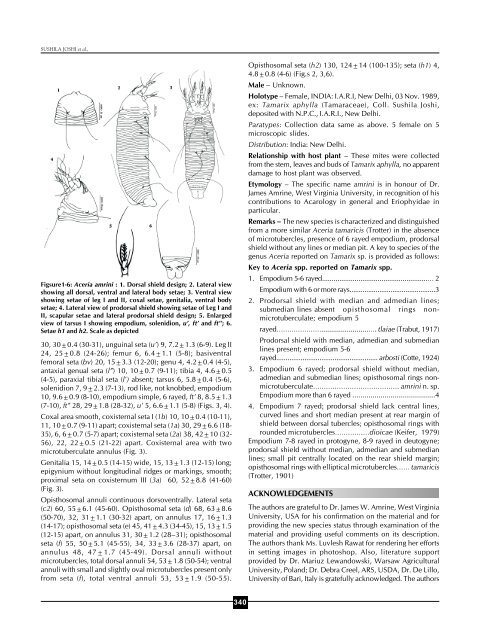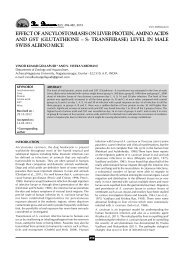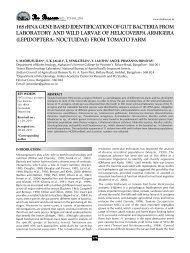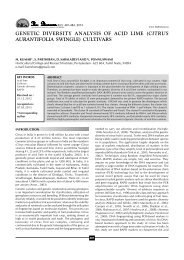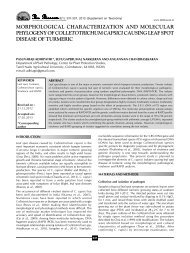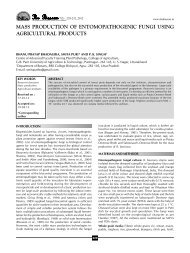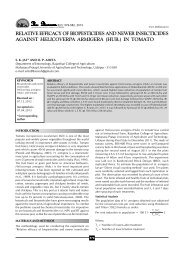A new Eriophyid mite (Acari: Prostigmata) from India - THE BIOSCAN
A new Eriophyid mite (Acari: Prostigmata) from India - THE BIOSCAN
A new Eriophyid mite (Acari: Prostigmata) from India - THE BIOSCAN
Create successful ePaper yourself
Turn your PDF publications into a flip-book with our unique Google optimized e-Paper software.
SUSHILA JOSHI et al.,<br />
Figsure1-6: Aceria amrini : 1. Dorsal shield design; 2. Lateral view<br />
showing all dorsal, ventral and lateral body setae; 3. Ventral view<br />
showing setae of leg I and II, coxal setae, genitalia, ventral body<br />
setae; 4. Lateral view of prodorsal shield showing setae of Leg I and<br />
II, scapular setae and lateral prodorsal shield design; 5. Enlarged<br />
view of tarsus I showing empodium, solenidion, u’, ft’ and ft’’; 6.<br />
Setae h1 and h2. Scale as depicted<br />
30, 30±0.4 (30-31), unguinal seta (u’) 9, 7.2±1.3 (6-9). Leg II<br />
24, 25±0.8 (24-26); femur 6, 6.4±1.1 (5-8); basiventral<br />
femoral seta (bv) 20, 15±3.3 (12-20); genu 4, 4.2±0.4 (4-5),<br />
antaxial genual seta (l”) 10, 10±0.7 (9-11); tibia 4, 4.6±0.5<br />
(4-5), paraxial tibial seta (l’) absent; tarsus 6, 5.8±0.4 (5-6),<br />
solenidion 7, 9±2.3 (7-13), rod like, not knobbed, empodium<br />
10, 9.6±0.9 (8-10), empodium simple, 6 rayed, ft’ 8, 8.5±1.3<br />
(7-10), ft” 28, 29±1.8 (28-32), u’ 5, 6.6±1.1 (5-8) (Figs. 3, 4).<br />
Coxal area smooth, coxisternal seta I (1b) 10, 10±0.4 (10-11),<br />
11, 10±0.7 (9-11) apart; coxisternal seta (1a) 30, 29±6.6 (18-<br />
35), 6, 6±0.7 (5-7) apart; coxisternal seta (2a) 38, 42±10 (32-<br />
56), 22, 22±0.5 (21-22) apart. Coxisternal area with two<br />
microtuberculate annulus (Fig. 3).<br />
Genitalia 15, 14±0.5 (14-15) wide, 15, 13±1.3 (12-15) long;<br />
epigynium without longitudinal ridges or markings, smooth;<br />
proximal seta on coxisternum III (3a) 60, 52±8.8 (41-60)<br />
(Fig. 3).<br />
Opisthosomal annuli continuous dorsoventrally. Lateral seta<br />
(c2) 60, 55±6.1 (45-60). Opisthosomal seta (d) 68, 63±8.6<br />
(50-70), 32, 31±1.1 (30-32) apart, on annulus 17, 16±1.3<br />
(14-17); opisthosomal seta (e) 45, 41±4.3 (34-45), 15, 13±1.5<br />
(12-15) apart, on annulus 31, 30±1.2 (28–31); opisthosomal<br />
seta (f) 55, 50±5.1 (45-55), 34, 33±3.6 (28-37) apart, on<br />
annulus 48, 47±1.7 (45-49). Dorsal annuli without<br />
microtubercles, total dorsal annuli 54, 53±1.8 (50-54); ventral<br />
annuli with small and slightly oval microtubercles present only<br />
<strong>from</strong> seta (f), total ventral annuli 53, 53±1.9 (50-55).<br />
Opisthosomal seta (h2) 130, 124±14 (100-135); seta (h1) 4,<br />
4.8±0.8 (4-6) (Fig.s 2, 3,6).<br />
Male – Unknown.<br />
Holotype – Female, INDIA: I.A.R.I, New Delhi, 03 Nov. 1989,<br />
ex: Tamarix aphylla (Tamaraceae), Coll. Sushila Joshi,<br />
deposited with N.P.C., I.A.R.I., New Delhi.<br />
Paratypes: Collection data same as above. 5 female on 5<br />
microscopic slides.<br />
Distribution: <strong>India</strong>: New Delhi.<br />
Relationship with host plant – These <strong>mite</strong>s were collected<br />
<strong>from</strong> the stem, leaves and buds of Tamarix aphylla, no apparent<br />
damage to host plant was observed.<br />
Etymology – The specific name amrini is in honour of Dr.<br />
James Amrine, West Virginia University, in recognition of his<br />
contributions to Acarology in general and <strong>Eriophyid</strong>ae in<br />
particular.<br />
Remarks – The <strong>new</strong> species is characterized and distinguished<br />
<strong>from</strong> a more similar Aceria tamaricis (Trotter) in the absence<br />
of microtubercles, presence of 6 rayed empodium, prodorsal<br />
shield without any lines or median pit. A key to species of the<br />
genus Aceria reported on Tamarix sp. is provided as follows:<br />
Key to Aceria spp. reported on Tamarix spp.<br />
1. Empodium 5-6 rayed.......................................................… 2<br />
Empodium with 6 or more rays..............................................3<br />
2. Prodorsal shield with median and admedian lines;<br />
submedian lines absent opisthosomal rings nonmicrotuberculate;<br />
empodium 5<br />
rayed…………………........................…. tlaiae (Trabut, 1917)<br />
Prodorsal shield with median, admedian and submedian<br />
lines present; empodium 5-6<br />
rayed...................................................... arbosti (Cotte, 1924)<br />
3. Empodium 6 rayed; prodorsal shield without median,<br />
admedian and submedian lines; opisthosomal rings nonmicrotuberculate………………………………….<br />
amrini n. sp.<br />
Empodium more than 6 rayed .........................................4<br />
4. Empodium 7 rayed; prodorsal shield lack central lines,<br />
curved lines and short median present at rear margin of<br />
shield between dorsal tubercles; opisthosomal rings with<br />
rounded microtubercles………….…dioicae (Keifer, 1979)<br />
Empodium 7-8 rayed in protogyne, 8-9 rayed in deutogyne;<br />
prodorsal shield without median, admedian and submedian<br />
lines; small pit centrally located on the rear shield margin;<br />
opisthosomal rings with elliptical microtubercles…… tamaricis<br />
(Trotter, 1901)<br />
ACKNOWLEDGEMENTS<br />
The authors are grateful to Dr. James W. Amrine, West Virginia<br />
University, USA for his confirmation on the material and for<br />
providing the <strong>new</strong> species status through examination of the<br />
material and providing useful comments on its description.<br />
The authors thank Ms. Luvlesh Rawat for rendering her efforts<br />
in setting images in photoshop. Also, literature support<br />
provided by Dr. Mariuz Lewandowski, Warsaw Agricultural<br />
University, Poland; Dr. Debra Creel, ARS, USDA, Dr. De Lillo,<br />
University of Bari, Italy is gratefully acknowledged. The authors<br />
340


